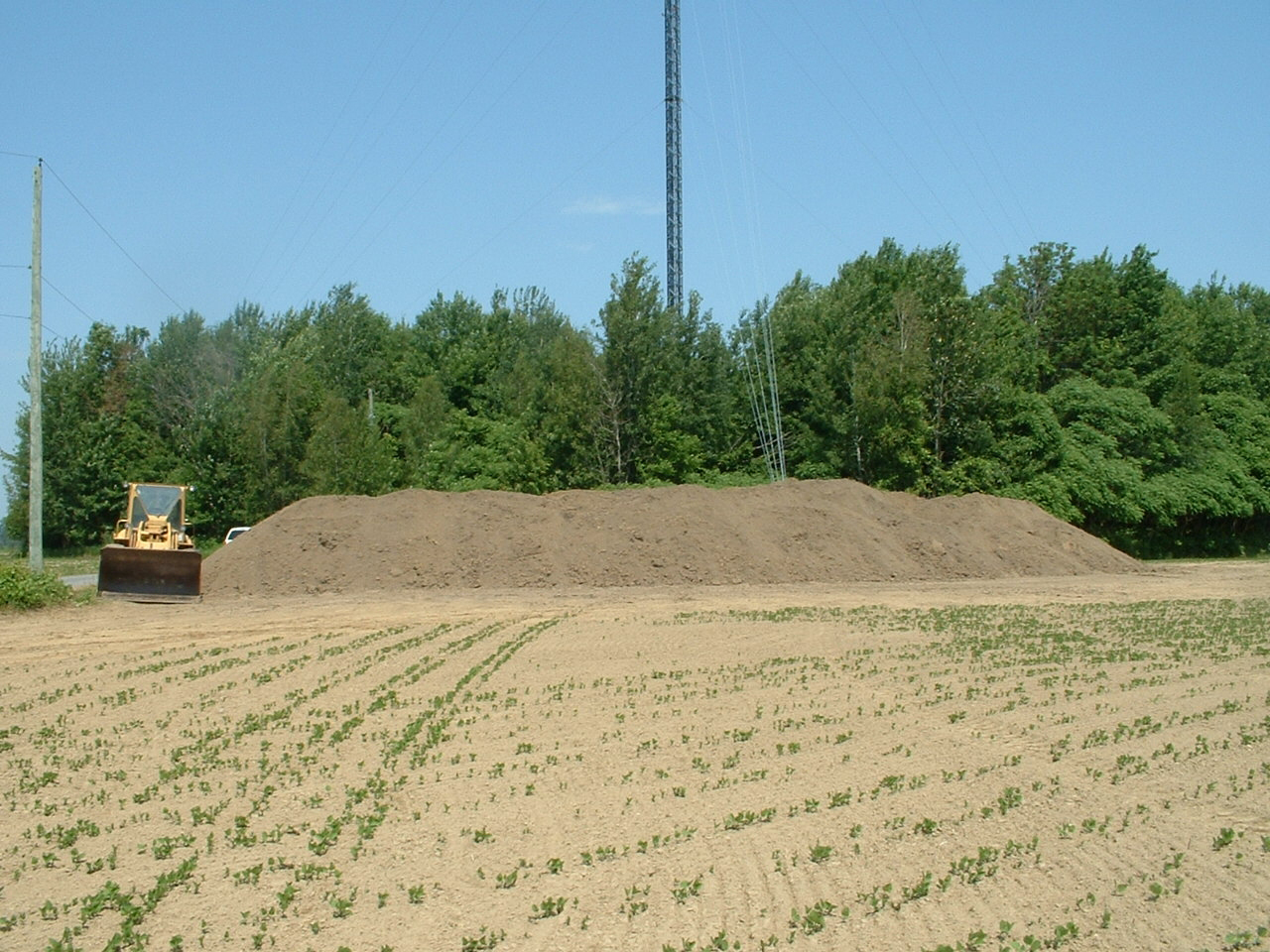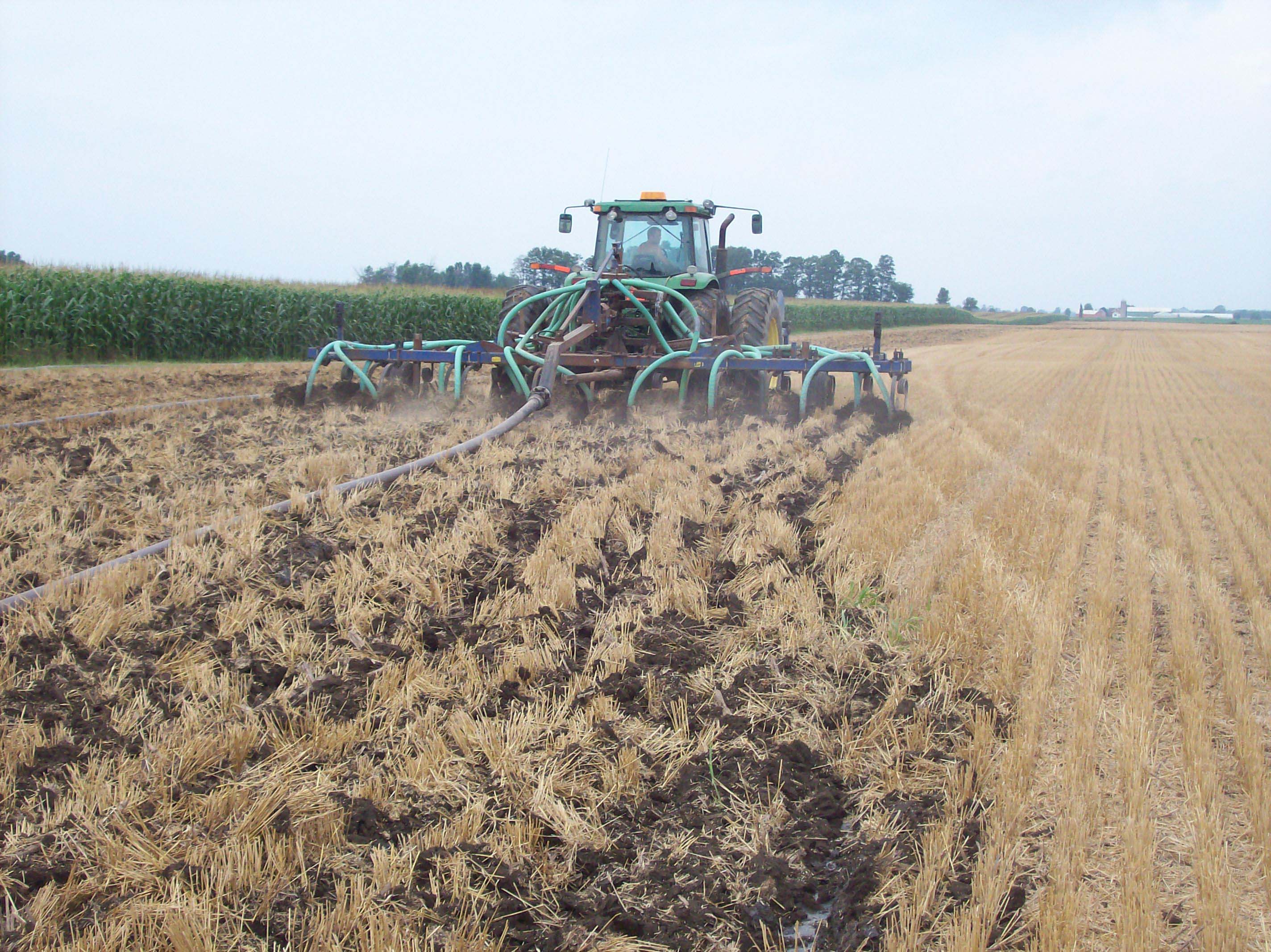Determining odour categories of non-agricultural source materials (NASM)
Learn about the 3 methods used to classify NASM into odour categories. This technical information is for Ontario producers.
ISSN 1198-712X, Published May 2023
Introduction
Non-agricultural source material (NASM) is material from non-agricultural sources that is applied to agricultural land under the Nutrient Management Act, 2002 (NMA), and O. Reg. 267/03. Providing valuable nutrients for crop production, NASM includes leaf and yard waste, fruit and vegetable peels, food processing waste, pulp and paper biosolids (Figure 1) and sewage biosolids. For more than 30 years, NASM has been safely applied to Ontario farmland. This fact sheet looks at the 3 methods used to classify NASM into odour categories.

Photo credit: Ministry of the Environment, Conservation and Parks.
NASM odour categories
One of the most common complaints about the land application of NASM stems from odour impacts. The odour of a NASM is affected by a number of factors, including the age of the material, the method and duration of storage and land-application practices.
To address potential odour issues associated with the beneficial use of NASM, O. Reg. 267/03 classifies material into 3 odour categories (OC1, OC2 and OC3), based on the detection threshold of the material. OC1 materials are less odorous than OC2 and OC3 materials. Materials that exceed the OC3 level cannot be applied to agricultural land under the NMA.
Table 1 shows the three odour categories and their corresponding ranges of odour detection thresholds.
| Odour category | Odour detection threshold |
|---|---|
| OC1 | Less than 500 odour units (OU) (OC1 < 500 OU) |
| OC2 | More than or equal to 500 OU but less than 1,500 OU (500 OU ≤ OC2 < 1,500 OU) |
| OC3 | More than or equal to 1,500 OU but less than 4,500 OU (1,500 OU ≤ OC3 < 4,500 OU) |
Note: 1 OU equals the number of unit volumes of odourless gas required to dilute one unit volume of odorous gas to reach the odour panel’s detection threshold.
The odour detection threshold (odour potential) of the material determines the odour category. Given the complexity of the human sense of smell to odours, categories are defined using both a standardized method using dynamic olfactometry and a panel of human assessors.
The detection threshold represents the dilution required for the material to have a 50% probability of detection by an evaluation panel. At greater detection thresholds, the odour potential increases for the material. Figure 2 shows a panel member assessing the odour of a NASM.

Photo credit: Pinchin Environmental Ltd.
The odour category affects land application standards, such as separation distances to neighbouring properties and the method of application. In general, greater setback distances and incorporation are required for more odorous materials.
OC3 materials also have special storage and transfer requirements (O. Reg. 267/03, part VI, land application standards 47). Figure 3 shows the injection method for applying OC3 material into a field. For more details on NASM storage, read the Ministry of Agriculture, Food and Rural Affairs (OMAFRA) fact sheet, Storage of NASM in a permanent nutrient storage facility.

There are 3 ways to determine the odour category of a NASM. These methods are outlined in the NASM Odour Guide (O. Reg. 267/03) associated with the NMA:
- basic method: odour category table
- odour category assignment and reassessment method (director’s assignment)
- odour assessment test method
Basic method: odour category table
A table of common NASMs and their corresponding odour categories helps regulators determine odour categories and the correct regulatory requirements. The assignment of NASM to categories is carried out using comparative and empirical assessment, the professional judgment of ministry staff and a review of odour regulations and standards in other jurisdictions.
The simplest method for odour assignment is to check the NASM odour category table (Nutrient management tables, September 14, 2009) to determine if the NASM is among the list of materials assigned to odour category OC1, OC2 or OC3.
If a NASM consists of a combination of multiple materials, you must consider the effects the combination of materials may have on the odour level of the resulting materials at the time of land application. A NASM resulting from a combination of multiple materials listed in the NASM odour category table could be represented by the odour category assigned to the most restrictive material in the mix. In some instances, interactions between listed materials or the inclusion of materials not listed in the NASM odour category table would require further assessment.
Use one of the other methods for assigning an odour categorization if:
- the NASM has not been assigned to an odour category in the NASM odour category table, or
- there is reason for disagreement with the assigned category
Odour category assignment and reassessment method (director’s assignment)
The OMAFRA director (director) can assign an odour category before or at the time of a NASM plan submission. The director assigns an odour category based on knowledge of the NASM and/or similar types of NASM.
Process
1. Client submits a written request for an odour category assignment
The request includes (as a minimum):
- a description of the material for land application
- a description of the process to generate the material — any treatment done to the materials prior to land application; storage method and duration before the material is land-applied
It is helpful to include any additional supporting information. Examples include:
- certificates of approval from previously approved land application of the NASM
- results of previous odour testing of the NASM
- results from past reviews of the NASM conducted by the Biosolids Utilization Committee (BUC)
- other supporting literature or research that substantiates the requested odour category
The director works in consultation with the client when assigning the odour category. However, the director has discretion to assign a NASM to a higher odour category where it is considered necessary to control odour impacts that may result from the land application or storage of the NASM. For example, the director can assign a different odour category in response to complaints or other information that becomes available, to minimize potential for impacts.
2. Director assigns a category or requests a test
The director’s response is either:
- an assigned odour category based on the information provided by the client, historical data, comparative review and empirical assessment, and the professional judgment of ministry staff, or
- a request for an odour assessment test
Odour assessment test method
If there is disagreement with the default category (basic method) or the director-assigned category, seek reclassification from OMAFRA using the odour assessment test method, in accordance with the NASM odour guide. The director can request a new odour assessment test. The intent of the odour assessment test is to determine the odour of the material when applied to the field. All odour assessment tests are conducted at the maximum possible application rate for the NASM and using a representative sample of the NASM that will be land-applied.
Process
1. Recommended: Client has a pre-consultation with OMAFRA
Contact the OMAFRA air quality engineer through the Agricultural Information Contact Centre at
2. Required: Client submits written odour classification methodology or a pre-test plan to the director
An odour assessment test, carried out without first discussing the methodology with the director, will not be accepted by the director as part of a NASM plan approval.
Electronic submissions: NutrientManagement.ONeSourceForms@ontario.ca
Paper submissions:
Attn: Manager, Innovation Engineering and Program Delivery (East)
1 Stone Road West
Guelph, Ontario N1G 4Y2
3. Client has NASM samples analyzed for odour
Once the pre-test plan is approved by the director, collect the NASM samples and have them analyzed for odour by a qualified laboratory in accordance with the approved methodology.
4. Client submits report
Submit a report of the applied methodology, analytical results and recommended classification to the director for approval.
Electronic submissions: NutrientManagement.ONeSourceForms@ontario.ca
Paper submissions:
Attn: Manager, Innovation Engineering and Program Delivery (East)
1 Stone Road West
Guelph, Ontario N1G 4Y2
5. Director assigns draft odour category
The director assigns an odour category based on the supplied testing results, historical data, comparative review and empirical assessment and the professional judgment of ministry staff. The proponent receives a draft odour category assignment for review and comment within 10 business days.
The director has the discretion to assign a NASM to a higher category, where necessary, to control odour impact that may result from land application or storage of the NASM.
The NASM odour category assignment is applicable to the NASM under the conditions tested during the odour assessment test. If the generation, processing, handling or storage of the NASM changes prior to land application of the material, the NASM odour category will have to be re‑evaluated.
How to use the odour category assignment
The director assignment of an odour category for NASM is separate and distinct from a NASM plan approval. A certified NASM consultant applies the odour category in the evaluation and preparation of NASM plan(s) for the referenced NASM.
Continue to apply best practices to minimize the potential for nuisance odours from land application of NASM. Develop a contingency plan for dealing with any unanticipated odours.
Resource
The University of Guelph, Ridgetown Campus provides information on NASM courses and certification and access to directories of certified businesses and persons under O. Reg. 267/03.
Disclaimer
The information in this document is provided for informational purposes only and should not be relied upon to determine legal obligations. To determine your legal obligations, consult the relevant law. If legal advice is required, consult a lawyer. In the event of a conflict between the information in this factsheet and any applicable law, the law prevails.
This fact sheet was written by Amadou Thiam, P. Eng., air quality and Benoit Lebeau, P. Eng., NASM, OMAFRA.